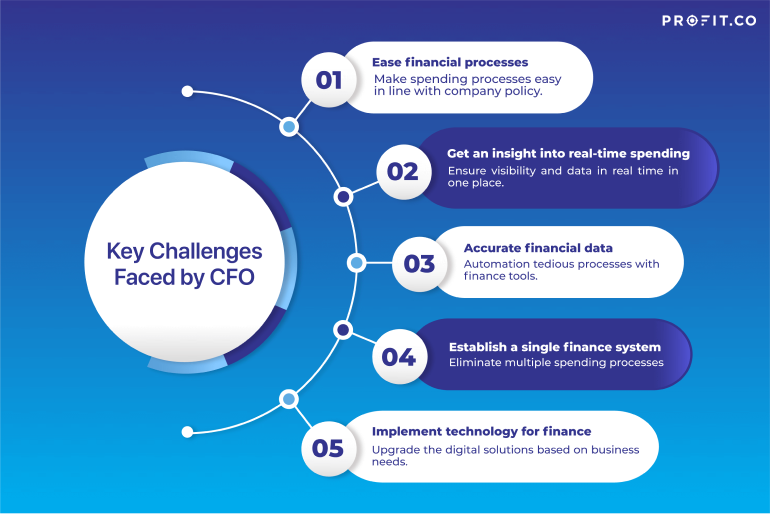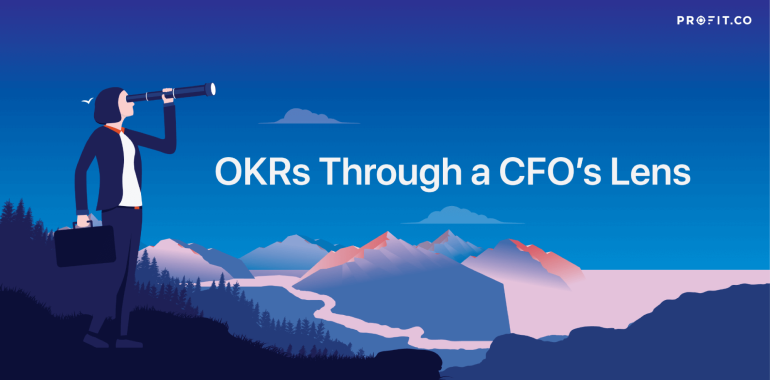The OKR framework was made popular by Google, and it credits much of its success to OKR’s goal setting model. Google has been using OKRs right from its initial days when they were just starting out. Soon after, other big companies like Twitter, LinkedIn, Dropbox, Oracle, and many other companies also followed suit and adopted OKRs.
OKRs are now being widely adopted by organizations as an effective approach to goal setting and performance management. OKRs are created at all levels, be it at the organizational level or different departmental levels — Sales, Operations, Marketing, Finance, etc., or even individual level.
The Finance team is very important to the organization as a lot of decisions are centered around finance and capital. Therefore, Finance OKRs are critical in driving business growth and growing revenue.
The Chief Financial Officer plays a vital role in successfully implementing OKRs for the organization. The CFO participates in the Company Strategy and OKR planning conversations. Since finance is also, in most cases, responsible for the company’s most important metrics Key Performance Indicators (KPIs) they are usually aware of the targets that have been set.
How can the CFO benefit from OKRs?
As the Chief Financial Officer (CFO) is in charge of the entire finance department, they need to be able to see the day-to-day business responsibilities and plan for the long term. A CFO needs to understand how seasonality, payments, a new product launch, or hires will impact the business. OKRs for CFOs come in very useful as it helps them understand how their finance team performs.
OKRs are planned around in-team and cross-functional discussions. For the CFO and the finance team, the OKRs are set around operational, and financial strategies aiming to improve the underperforming systems and processes.
Key Challenges faced by CFO
Let’s look at the 5 most significant challenges and priorities of the CFO and their finance team to work smarter and more efficiently.
1. Ease financial processes
2. Get an insight into real-time spending
3. Accurate finance data
4. Club all similar finance systems into one system
5. Implement tech for Finance
1. Ease financial processes.
It’s on the CFO and the finance team to make sure that everyone in the organization spends responsibly, to mitigate any financial risk and keep the organization safe. OKRs plays an important role in tracking the financial strategies, and easing the overall financial processes.
Here are 2 ways to ensure that this happens:
-
Create easy-to-follow processes.
It might seem like every other department other than the finance department doesn’t take the same level of care with company money as the finance department does. It’s not because they don’t care. It’s because they probably find the process too tedious or don’t know what the right procedures are. Employees want convenience.
Solution:
Make spending processes easy. Keep it simple and uncomplicated, while still being rooted in company policy. Create a platform that has everything built into it, be it in determining spending limits or building in managerial approval. Everything becomes much smoother and easier when there are tools and platforms to take care of things. OKRs can help upgrade the digital competencies of the finance team to enable digital implementation so that it does not seem like the employee is being ‘policed’.
-
Give employees autonomy
Employees give their best when they know the company trusts them. There needs to be a way for them to be able to make decisions quickly and make transactions if the decision involves having to spend or use company credit card / money, without having to get approval from the higher-ups; what if they are not available right at that moment when the organization needs it.
Solution:
Have a system in place to give employees access to the spending systems in the organization, but with limits built into it to keep spending in control.
Using OKRs to simplify processes and build autonomy
- CFOs can use OKRs to standardize resource management practices across the organization.
- OKRs for financial departments can ensure the speed of processing payments, budgeting and approval for requests from teams are constantly improved.
- Spending at team and individual levels can be a part of OKRs, where the project manager sets guidelines for spending within the team and monitors them along with other OKRs.
- Depending on how employees achieve their OKR goals in terms of spending, cost efficiency and the results they produce with allocated resources, the CFOs can analyze and constantly change spending limits for individuals during reviews. Sometimes the CFO may have to change his OKR goal setting strategy to achieve the best results.
OKR examples
Objective: Simplify resource management processes and enable individual and team level spending judiciously
Key results
- Improve time taken for approval and payment processing by the finance department by 50% in three months.
- Meet with team leaders within a week to finalize resource allocation for each team.
- Meet with team leaders within 15 days to allocate resources, brief them on spending limits, set financial goals for individuals, choose the right financial metrics to measure successes and failures, and review procedures.
- Achieve 100% adoption of financial OKRs at the end of this quarter.
2. Get an insight into real-time spending
In order to be in control of company finances, it is important to see how much is being spent. Not just at the end of the month because employees/teams might have already spent the money, therefore once a month might be too late for the CFO and the finance team to do anything.
OKRs make it possible to have visibility and data in real time, which is very important if the CFO and team want to be in control of company finances.
Solution:
Get payment methods built into a central system.
This solves the problem of claims that are submitted at the end of the month (that the finance team might not fully agree with) and also the problem of credit cards especially if there are recurring payments involved — there may be commitments made for transactions that are yet to be processed. All of this might throw things off balance.
Having visibility into all spends that happen, in one place in an easy to access manner can help the finance team be in control of company spends and finance. A centralized platform that has all operational spends tied into it enables the finance team and CFO to see spending as it happens, from anywhere, without the need for any physical claims or credit card statements.
Using OKRs to align the workforce to payment methods built into the system
- CFOs can use OKRs to align the workforce towards new payment methods that are introduced into the centralized system.
- They can set an ambitious target and with OKR alignment bring in a vast majority of the workforce into the payment system so that the payment data will be almost real-time and accurate as soon as possible.
- CFOs can implement revenue recognition tools to fix the right period the spendings appear in the system synchronized with the period of the financial assessment.
OKR examples
Objective: Introduce new payment methods and revenue recognition tools in the system and obtain real-time data
Key results
- Update the old payment processes and introduce new payment methods within the system in one month.
- Identify the most suitable revenue recognition tool within two months.
- Create internal emailers to make employees aware of the new payment methods.
- Achieve 80% adoption of new payment methods and revenue recognition tools before the end of the quarter.

3. Accurate finance data
Having to input the same data over and over again, and having to check it multiple times to ensure the data entered is correct can be a huge time sink, and one can also not be too sure of its accuracy when it’s done manually. OKRs can enable digital transformation by helping automate the finance process.
Automation specifically for some tedious processes:
- Expense reports
Expense reports and claims can be a tedious spending process. It’s not fun to do these manually. Therefore minimizing the manual effort and automating most of it can make the process less cumbersome.
Solution:
Submit all expense reports digitally.
Finance tools exist that let employees enter their expense claims directly into the system. This system includes the claim amount, the reason for the spending, the manager who approved the expense and the receipt.
This makes taking care of expense claims a breeze, because all that the finance team now has to do is export this data into their system. This saves the finance team days of work and data entry.
- End of month closing
End of month closing is a stressful time for the CFO and the finance team. It involves the finance team gathering data from different sources and making sure that the company book is balanced every month. Needless to say, it’s not easy to keep track of and integrate data sources.
Solution:
This is when automation can be very useful. An OKR system can improve the finance staff’s digital skills in terms of being able to manage the closing more effectively. If spending details are digitized, then there’s no need for manual entry. Also, there are specific finance tools that can automate the process and can speed it up considerably.
- Automate for accuracy
It’s a common perception that the more hands on we are, the better the quality of work. The truth is, human error is one of the number one problems in everyday accounting. Entering expenses manually can be a highly inefficient thing to do.
Solution:
Automating can free up a lot of time for employees to focus on more important things, can speed the process up, and most importantly, do it with utmost accuracy and efficiency every single time. All that is required is the right tools to automate. OKRs can drive this digital transformation by helping with automation and taking manual error out of the equation.
Using OKRs for digitizing financial operations
- CFOs can use OKRs for a quick transformation of financial operations through digitalization and automation.
- They can set learning goals to learn new technologies that eliminate the need for submission of reports, data entry, and doing repetitive tasks manually.
- They can set goals to use technologies and reduce the time for processing requests and carrying out financial operations.
- They can also set goals to reduce human error through automation.
OKR examples
Objective: Achieve digitalization and automation of financial operations by the end of the quarter.
Key results
- Meet with managers and standardize tools and methods for generating and submitting digital reports within 10 days.
- Take an audit of software skills amongst the workforce and organize suitable training aimed at data entry and automation during the first month.
- Achieve 70% adoption of digital reporting by the end of the quarter.
- Achieve 70% multiple spending processes at the end of this quarter.
- Reduce human errors by 75% by the end of quarter.
Beware of little expenses. A small leak will sink a great ship.
4. Club all similar finance systems into one system
When there are multiple spending processes that are similar, and the way to submit invoices for these are all different, it can get very confusing for the employees, and very time consuming and tedious for the finance team.
Solution:
The CFO needs to decide on having a system in place that can club all these similar spending processes in one system.
This makes it easier for everyone, with less onboarding to new systems, and fewer complicated procedures and errors. An OKR system can upgrade the digital competencies of the finance team to enable the digital implementation of various processes.
Using OKRs to standardize spending processes and align the workforce
- CFOs can use OKRs to standardize the spending process and implement a single, widely-adopted process.
- They can align the team to follow a single spending process and set ambitious goals for rapid adoption
- OKRs for financial departments can ensure that they upgrade their digital skills so that they can quickly adopt new technologies and shift to digitalized processes.
OKR examples
Objective: Eliminate multiple spending processes and upgrade the digital skills of the team
Key results
- Identify the multiple spending processes within 10 days.
- Meet with the team in 2 weeks and bring consensus towards standardizing a single process.
- Achieve 100% adoption of the spending process by the end of the quarter.
- Identify members who lack exposure to digital implementation of various processes and organize suitable training.
- Achieve 60% digitalization of various financial processes by the end of the quarter.
5. Implement Tech for Finance
The technology landscape is vast and ever expanding, which makes it hard to decide when it comes to technology investment — especially for CFOs as they have to plan ahead for the company.
There exist specialized tools that CFOs can choose from depending on their requirements. OKR implementation using an agile software will highly benefit the CFO as it is easy to track progress across financial landscape of the teams. While it’s good to have so many options, it can also be a nerve-wracking task to decide what to choose, given the plethora of options out there
Solution:
OKRs come in handy to help measure what truly matters and eliminate measurements that have no impact on the financial performance.
To make this selection process less daunting, the CFO can work with a technology advisor to assess the needs and help the CFO make the right decision.
The tech advisor can help narrow the list of potential solutions given the business needs of the company. The CFO can use OKRs or financial KPIs to assess and track what’s crucial.
Using OKRs to identify metrics and the tools to measure them
- CFOs can use OKRs to quickly to identify the metrics that matter and the tools suitable for measuring the financial performance using the metrics
- Eliminating any vanity metrics that do not show the actual financial performance
OKR examples
Objective: Measure financial performance accurately
Key results
- Discuss with the team during first two weeks and identify the ways to measure actual financial performance
- Discuss with the team, eliminate vanity metrics and narrow down the key metrics to 20 within the first month.
- Meet with a software solution consultant, communicate the requirements, analyze the options and finalize software tools to measure the identified key metrics within the first two months.
- Procure the tools and integrate them with your financial system to start measuring financial performance using the metrics by the end of the quarter.
Final thoughts
The CFO and the finance team must consider many aspects of the business. CFOs’ roles and responsibilities have changed considerably over the past decade, evolving from a transactional role to a strategic business partner. OKRs play an important role in operationalizing the financial strategies. OKR tools can helps shape strategy, and sets up the controls that allow the business to track and react to change, to report, and manage day-to-day operational aspects of finance. Book a free demo with our team to learn more about how OKR software can optimize your organization’s performance!

